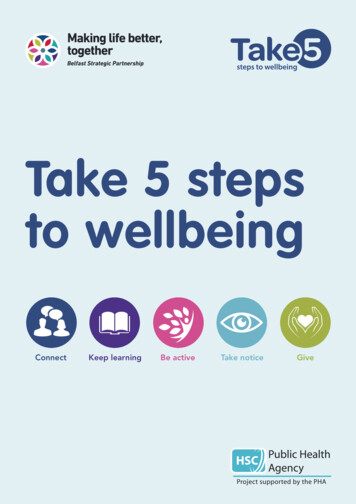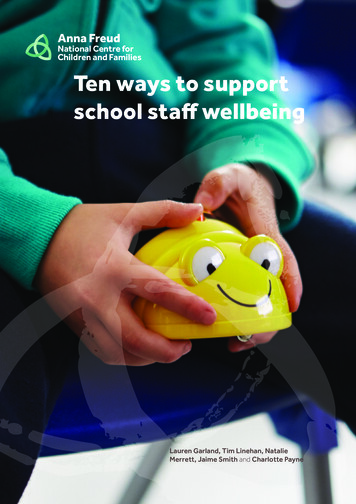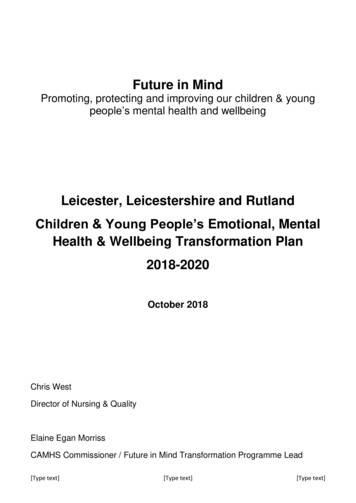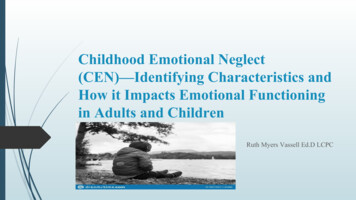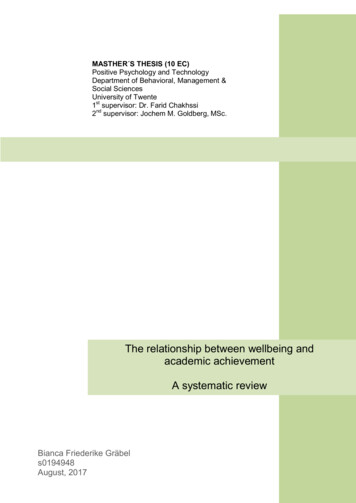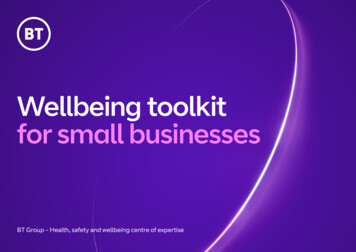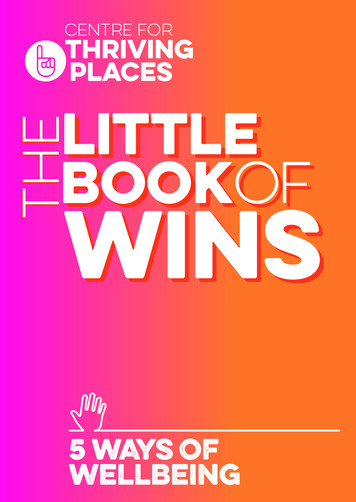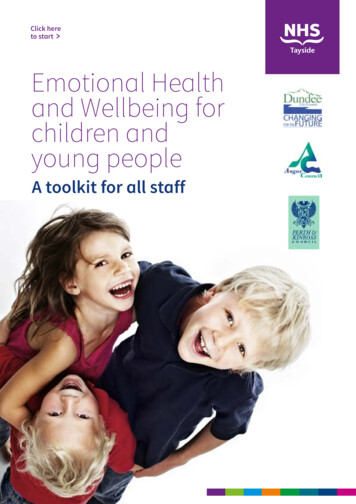
Transcription
Click hereto start Emotional Healthand Wellbeing forchildren andyoung peopleA toolkit for all staff
CONTENTSIntroductionWhat is emotionalhealth and wellbeingPathwaysNAK – Noticing, Asking,Knowing what to do next.Feel you needsome support?Involving another serviceStaff WellbeingWorking OWLEDGMENTSThis guide was writtenand produced by theMental Health InnovationFund Team (CAMHS)NHS Tayside.It was created anddeveloped throughconsultation with staffacross Tayside. (AngusCouncil, Dundee CityCouncil, Perth and KinrossCouncil and NHS Tayside).With special thanks to:Mental Health andWellbeing Priority Group.Introduction to the toolkit 2Section 1What is emotional healthand wellbeing APPENDICESCAMHS Referral Criteria 253School Nurses Pathwayand Referral Criteria 26School Nurses Referral Criteria 27Education Psychology Service Leaflet 30Printable information Leaflet for Parents References 32Section 2Pathways 7Section 3NAK – Noticing, Asking,Knowing what to do next. 9Notice: there is a change/difference 10Ask: speak to the child/young personusing open communication skills 11Knowing what to do next:Remain concerned about a child/YP? 12Section 4Feel you need some support? 13Section 5Involvement of another service? 21Section 6Staff Wellbeing 23Section 7Working with Parents/Carers 24133
INTRODUCTIONIntroductionWhat is emotionalhealth and wellbeingPathwaysNAK – Noticing, Asking,Knowing what to do next.Feel you needsome support?Involving another serviceStaff WellbeingWorking withParents/CarersAPPENDICESREFERENCESINTRODUCTION TO THIS TOOLKITWhat is the purposeof this toolkit?This toolkit has a clearpurpose to be a valuableand accessible tool whichsupports all universalstaff in supportingchildren and youngpeople’s emotionalhealth and wellbeing. Itaims to raise awarenessof emotional healthand wellbeing and theimportance of prioritisingearly intervention,highlighting the roleall staff can play inpromoting this withthe children and youngpeople they work with.Research demonstrates that staff cansupport the emotional health andwellbeing of children and young peopleby building positive relationships, helpingthem to develop good coping and problemsolving skills and through buildingresilience. Everything is underpinned bythe relationships staff have with childrenand staff’s understanding that theserelationships can make a real difference.Staff who work within universal servicesare often best placed to notice even thesmallest change in presentation or moodof a child or young person, which mayreflect an emotional health or wellbeingdifficulty that needs help and support.It is important that all staff have anunderstanding of how best to notice andsupport children and young people at thisearly stage so that help can be offeredbefore the difficulties increase. The morestaff committed to this the better, childrenand young people choose who they sharethings with and more often than not, thiswill not be the person identified as beingtheir key adult. Section 3: Notice, Ask,Know what to do next (NAK) in this toolkitaims to equip staff with the confidenceto respond to emotional health andwellbeing concerns.2The remaining sections of this toolkitsuggest pathways, tools, resources andexternal agency resources and servicesavailable to support children’s emotionalhealth and wellbeing.It is hoped that this toolkit will help staffto implement the principles and practiceof underpinning policies such as GettingIt Right for Every Child, Curriculum forExcellence, Health Promoting Schools,Scottish Mental Health Strategy 2017-2027,Tayside Plan for Children, Young Peopleand Families 2017-2020 and TaysideChildren and Young Peoples MentalHealth Strategy, (ScotPHN) ‘Polishing theDiamonds’; Addressing Adverse ChildhoodExperiences in Scotland, 2016.
SECTION 1IntroductionWhat is emotionalhealth and wellbeingPathwaysNAK – Noticing, Asking,Knowing what to do next.Feel you needsome support?Involving another serviceStaff WellbeingWorking withParents/CarersAPPENDICESREFERENCESSECTION 1WHAT IS EMOTIONALHEALTH AND WELLBEING?There is growingacknowledgement of thevalue of good mentalwellbeing to individuals.It can contribute toheightened self-esteem,optimism and a sense ofcontrol and coherence.Those experiencingpositive mental wellbeingare more confident,assertive and able to: develop emotionally,creatively, intellectuallyand spiritually face problems, resolveand learn from them cope with adversities,show resilience initiate, develop andsustain mutuallysatisfying personalrelationships contribute to family andother social networks,local community andsocietyChildren and young people’s emotional health and wellbeing can be impactedby a number of different factors which result in distressed behaviour which isreactive rather than a clinical mental health difficulty as shown in the diagrambelow.Self Care and Social SupportUniversal ServicesHEALTHYAdditional/Professional CareTargeted and Specialist ServicesNormalFunctioningCommon nctionalImpairmentClinical DisorderSevere andPersistantFunctionalImpairmentNormal moodfluctuationsIrritable/impatientAnger, anxiety,lingering sadness,tearfulnessSignificant difficultywith emotionsand thinkingHopelessnessHigh level of anxiety,panic attacksTakes thingsin their strideConsistentperformanceNormal sleepPatternsPhysically andsocially activeUsualself confidenceComfortablewith othersNervousness,sadness, etfulnessPreoccupationTrouble sleeping(more often infalling asleep)Decreasedperformance inacademics or at workLowered energySignificantlydisturbed sleep(falling asleep andstaying asleep)Difficulty in relaxingIntrusive thoughtsDecreasedsocial activity empathise with othersAvoidance ofsocial situations,withdrawalSEVEREDepressed moodFeeling overwhelmedConstant fatigueDisturbed contactwith realitySignificantdisturbance inthinkingSuicidal thoughtswith intentDistorted body imagewith low weight use and enjoy solitude play and have fun.”Good Mental Healthfor All, NHS HealthScotland (2016-2010)3
SECTION 1IntroductionWhat is emotionalhealth and wellbeingPathwaysNAK – Noticing, Asking,Knowing what to do next.Feel you needsome support?Involving another serviceMost children and youngpeople experience goodmental health throughouttheir lives and althoughthey will experienceperiods of poor emotionalwellbeing it is unlikely, formost, that they will go onto develop a mental illness,particularly if they haveaccess to the right support.All staff can and do play arole in offering appropriatesupport to children andyoung people no matterwhere they are on thecontinuum, however theearlier this support can beoffered, the better in termsof outcomes.Staff WellbeingWorking withParents/CarersAPPENDICESREFERENCESFactors which may impactemotional health and wellbeingResources for PromotingGood Emotional Health andWellbeing at a Universal LevelInequality related to disabilities, age,sex, gender, sexual orientation, ethnicityand background can all affect mentalwellbeing and incidence of mentalillness. Some groups are more likelythan others in our society to experiencemental ill-health and poorer mentalwellbeing – for example, people whohave experienced trauma or adversechildhood events, people who havesubstance use problems, people whoare experiencing homelessness, peoplewho are experiencing loneliness or socialisolation, veterans, refugees and asylumseekers. There may also be specific issuesaround access to services and support forthose living in remote and ruralcommunities.”The active promotion of good emotionalhealth and wellbeing in schools is nowfirmly rooted in policy. Health PromotingSchools, Getting It Right For Every Child,Curriculum for Excellence and the MentalHealth Strategy for Scotland. Eachmake reference to emotional health andwellbeing as being the ‘responsibility of all’with schools identified as a key resource forprevention, early intervention and ongoingsupport for children and young people.Mental Health Strategy; 2017-2027The national movement around AdverseChildhood Experiences has helped toreinforce the message that children’s earlyexperiences impact significantly on theirlater outcomes – a message that is alsoemphasised in a nurturing approach andtrauma informed practice, and has beenfurther developed by the growing field ofneuroscience.”Emotional health and wellbeing should beviewed first and foremost as a preventativerather than crisis intervention measure.Universal tools and resources can help ina preventative way to increase the overallknowledge and skills of children andyoung people to keep themselves andothers mentally well. The specific contentbeing delivered will be dependent on whois being taught. However, emphasis shouldbe on the promotion and developmentof the skills, knowledge, language andconfidence to seek help, as needed, forthemselves and others.Nurture, Adverse Childhood Experiencesand Trauma informed practice: Makingthe links between these approaches.Education Scotland, 2018*Examples demonstrating how children/young people move through the continuum can be viewed H01X6b3jTQF85GLgbFl/when-i-worry-about-things4
SECTION 1IntroductionWhat is emotionalhealth and wellbeingPathwaysNAK – Noticing, Asking,Knowing what to do next.Feel you needsome support?Involving another serviceStaff WellbeingWorking y Protective Factorsin Building ResilienceWhat is resilience?Summary1. Resilience is the capacity to bounce back fromadversity. Protective factors increase resilience, whereasrisk factors increase vulnerability. Resilient individuals,families and communities are more able to dealwith difficulties and adversities than those with lessresilience.There are four core protective factors that increasethe resilience of children and young people:2. Those who are resilient do well despite adversity,although it does not imply that those who are resilientare unharmed – they often have poorer outcomes thanthose who have low-risk background but less resilience.This applies to health outcomes and affects success ina range of areas of life across the life course. Evidenceshows that resilience could contribute to healthybehaviours, higher qualifications and skills, betteremployment, better mental well-being, and a quickeror more successful recovery from illness.4. An interest, hobby or skill that the child or youngperson values in themselves.”1. A relationship with nurturing care providers(if they are not the origin of adversity)2. Social connectedness with a supportive peer group3. The ability to problem solve and communicateAddressing Adversity, Young Minds,funded by NHS England, 2017Research has identified protective factors which canpositively influence our sense of emotional health andwellbeing and decrease the likelihood of difficultiescontinuing or progressing. For most children and youngpeople the presence of these protective factors is all theyneed to restore good emotional health. These protectivefactors can be made readily available to children andyoung people in school in the following ways:3. Resilience is not an innate feature of some people’spersonalities.4. Those who face the most adversity are least likely tohave the resources necessary to build resilience. This‘double burden’ means that inequalities in resilienceare likely to contribute to health inequalities.Relationships The key protective factor for children and young peopleexperiencing emotional health and wellbeing difficultiesis the presence of one positive, consistent, caring adultin their lives. Someone who they can talk to, who listensand is available to them. Having a relationship whichallows the opportunity to talk to someone will, in mostcases, be all that is needed to help children return to astate of good emotional health and wellbeing.5. Schools have a key opportunity to build resilienceamong children and young people, and there is a rangeof ways in which local authorities can support andencourage schools to take action.6. Actions to increase resilience can be targeted atdifferent levels – they can aim to increase achievementsof pupils; to support them through transitions andencourage healthy behaviours; to promote betterinterpersonal relationships between people –particularly parents or carers and children; and tocreate more supportive, cohesive schools that supportboth pupils and the wider community. Healthy adult role models provide consistency andpredictability. They can also role model good copingstrategies and problem solving skills which children andyoung people can observe and learn from.5
it right for everychild practicemodel AND3. GettingPARTNERSHIPWORKING:IMPACTOUTCOMES FOR CHILDREN AND YOUNG PEOPLESECTION 1IntroductionWhat is emotionalhealth and wellbeingPathwaysNAK – Noticing, Asking,Knowing what to do next.Feel you needsome support?Staff WellbeingWorking withParents/CarersAPPENDICESInvolvingserviceThis guidance beginswithanotherthe impactandoutcomes of partnership working for childrenREFERENCESand young people. It is important to consider the Getting it right for every child 6practice model and My world triangle which place the young person at the centre.WiderallowsenvironmentThiseveryone involved to consider systematically:Other protective factors relate to the school environmentthe opportunitiesin schoolto boostan andHowthe childavailableor youngpersonis growingand developingindividual’s sense of success, engagement, achievementa sensetheof belonging.protectivefactorscan from the people who look after him or her andWhatchild orTheseyoungpersonneedsDANCEON PARTNERSHIPWORKINGBETWEENALLIED HEALTH PROFESSIONS AND EDUCATIONbe fostered through activities, hobbies and through theof interests. nurturingThe impactof the child or young person’s wider world of family, friends and community. PARTNERSHIPWORKING:IMPACTGettingit righteverychildmodel ANDGetting it Rightfor EveryforChild,ResilienceMatrixpracticeOUTCOMES FOR CHILDREN AND YOUNG PEOPLEThis guidance begins with the impact and outcomes of partnership working for childrenand young people. It is important to consider the Getting it right for every child 6practice model and My world triangle which place the young person at the centre.This allows everyone involved to consider systematically: How the child or young person is growing and developing6 Scottish Government (2008) GIRFEC overview. What the child or young person needs from the people who look after him er The impact of the child or young person’s wider world of family, friends and community.Getting it right for every child practice modelHEALTHYCONFIDENTResilience Building toolsUseful tools can be found on page 17 of this toolkit.6 Scottish Government (2008) GIRFEC verview
SECTION 2IntroductionWhat is EmotionalHealth and Wellbeing?PathwaysNAK – Noticing, Asking,Knowing what to do next.Feel you needsome support?Involving another serviceStaff WellbeingWorking withParents/CarersAPPENDICESREFERENCESSECTION 2PATHWAYSManaging an emotional wellbeing issue in your school.Class TeachersNNoticeNotice that there is change/difference in the childRefer to continuum ofemotional health andwellbeingAAskSpeak to a child using opencommunication skillsIf there are childprotection concernsrevert to childprotection policyFollow schoolreporting protocolKKnow what to doRemain concernedabout the childFeel confident tomanage issue, arrangeto meet againFEEL YOU NEEDSOME SUPPORT?Continue to use opencommunication skillsInform/discuss withGuidance/Deputy Head/Head Teacher/PupilCare and Support/Named PersonConfident thatsituation has improvedMonitor the child; check-inperiodically7
SECTION 2IntroductionWhat is EmotionalHealth and Wellbeing?PathwaysNAK – Noticing, Asking,Knowing what to do next.Feel you needsome support?Involving another serviceStaff WellbeingWorking uty Head/Head Teacher/Pupil Care and SupportEmotional health andwellbeing concernraised by member of staffSenior/Guidance staffmeet with the childGather informationfrom other teachersFeedback tostaff memberwho raised initialconcernOPTIONSWhere relevant,share informationwith othersContinue to work with childin school, following schoolprotocolSeek additional supportfrom school based staffOrganise team around theChild/StagedIntervention MeetingInvolvementof another service8
SECTION 3IntroductionWhat is EmotionalHealth and Wellbeing?PathwaysNAK – Noticing, Asking,Knowing what to do nextFeel you needsome support?Involving another serviceStaff WellbeingWorking withParents/CarersAPPENDICESREFERENCESSECTION 3NAK – NOTICING, ASKING,KNOWING WHAT TO DO NEXTNAKThere’s a NAK to responding to emotionalhealth and wellbeing difficulties.As someone who works in a universalservice, it would be impossible to solve allthe emotional difficulties of all childrenand young people, but that doesn’t meanyou should ignore them either. As anindividual member of staff there are threethings you can do; there’s a NAK to helping.As an adult who works with childrenand young people you expect to witnessa range of emotions and behaviours.The trick is to figure out when thosecues fall outside the ‘healthy’ range onthe continuum. Significant changes inappearance, behaviour or academicperformance may indicate that a childis struggling and could benefit fromadditional support.NAKNotice a change/differenceAsk a questionKnow what to do nextSometimes children and young people willlack the skills to deal confidently with theissues they are facing in their lives. Thismay manifest in behavioural responsesand high stress levels which bring them toyour attention. It is important for all staff tobe able to recognise warning signs and beable to confidently respond.9
SECTION 3IntroductionWhat is EmotionalHealth and Wellbeing?PathwaysNAK – Noticing, Asking,Knowing what to do nextFeel you needsome support?Involving another serviceStaff WellbeingWorking withParents/CarersAPPENDICESREFERENCESNotice: there is a change/differenceResearchers have identified the following behavioursassociated with stress, low mood and/or anxiety thatare warning signs to notice. Please note this list is onlya guide. Some of the behaviours listed are normalfluctuations of human behaviour, particularly in theteenage years or during puberty. Also someone who isexperiencing emotional wellbeing difficulties may notdisplay any obvious outward changes in behaviour,or these behaviours may indicate something else. Anynoticeable, sustained change in behaviour is probablyworth discussing with the child/young person in an ageappropriate way; it is important to be guided by your ‘gutfeelings’. Take into account developmental differences;children who function differently to their peers. Be curiousabout quiet and overly compliant children. As a simpleguide, developmentally children should be non-compliantone third of the time. If they’re not, why not?Changes to sleep and/or eatingChanges in appetite or food and eating related behaviourWeight loss or weight gainTiredness despite sleeping a lotDifficulty sleeping (either finding it hard to fall asleep orwaking early and unable to get back to sleep)Frequent nightmaresBedwetting or soiling when previously dry and cleanChanges in activity and relationshipsLoss of interest in previously enjoyed activitiesBecoming more isolated from family or peer groupMissing school either to play truant or staying at homeReporting headaches and/or stomach-achesAvoiding certain situations/places or peopleNot talking as muchChanges in behaviourLoss of concentration or ‘muddled’ thinkingFalling behind with school workChallenging behaviourSaying they want to die or making comments like ‘peoplewould be better off if I wasn’t here’Difficulty separating from loved onesDoing or saying strange thingsBecoming secretiveExcessive exercisingEngaging in risky behaviour such as drinking alcohol orusing drugsInappropriate sexual behavioursChanges to physical appearanceNo longer taking the usual care for appearance orpersonal hygieneWearing long sleeves and trousers even on warm daysReluctance to change for PE or roll up sleevesUnexplained injuryLooking tired or sadChanges to observed moodMood swingsIrritabilityAngerLow mood/sadness/crying for no obvious reason or morethan usualExcessive worry, anxiety or panic attacksSudden lifting of sadness after a period of mental distressSeeming withdrawn or paranoidLoss of confidenceSudden unusual euphoriaReporting feelings of worthlessness or hopelessness10
SECTION 3IntroductionWhat is EmotionalHealth and Wellbeing?PathwaysNAK – Noticing, Asking,Knowing what to do nextFeel you needsome support?Involving another serviceStaff WellbeingWorking withParents/CarersAPPENDICESREFERENCESAsk: speak to the child/young personusing open communication skills3. Don’t try to fixThe best way to understand the reasons behind behaviouris to have a supportive, empathic conversation with thechild or young person about the things you have observed.If you are worried about a child or young person orindeed they ask to speak to you about their concerns itcan sometimes be difficult to know what to do next. Manystaff are worried about starting the conversation for thefollowing reasons:Remember we want to help children develop the skillsto solve their own problems. Instead of “what can I doto help”, tryWhat is one thing that you think might help you”.You may need to help them identify this.What if I can’t help?What if I make it worse?What if I say the wrong thing?“What things have helped before?”4. Ending the conversationThe following steps aim to help staff to feel more confidentabout having conversations with children and youngpeople and reassure them that saying something alwayshas a better outcome than doing nothing.Give a summary of the things you have talked aboutand the agreed solutions to try.Thank them for talking to you about things and clarifynext steps.Proceed for the class teacher pathway on page 7Proceed for the head teachers pathway on Page 81. NoticeThe important thing is to notice and check that the childis okayI’ve noticed you’re not your usual self, what’s up?”“You seem a bit quiet, I’m wondering what’s going on”“Remember, this is a safe place to talk – you can alwaystalk to me in confidence.”Doing this WILL NOT make anything worse and willcommunicate that you care enough to ask.2. ListenExplain the confidentiality policy to the child/youngperson.Try not to worry about what you are going to say, themost important thing is to listen. Focus on Listening.The child or young person should be talking threequarters of the time.Focus on feelings when you do talk.Use open questions if you need to encourage the youngperson to keep exploring their feelings.Make sure your body language demonstrates you arelistening.11
SECTION 3IntroductionWhat is EmotionalHealth and Wellbeing?PathwaysNAK – Noticing, Asking,Knowing what to do nextFeel you needsome support?Involving another serviceStaff WellbeingWorking withParents/CarersAPPENDICESREFERENCESKnow what to do next:Remain concerned about a child/YP?4. Would it help to discuss this with a colleague? Doesanything need to be shared with the child/youngperson’s named person? The named person mightconsider:In the event of a child/young person disclosinginformation to you:There are several things for you to consider;What is getting in the way of this child’s or young 1. If this is a child protection concern, follow childprotection procedures.person’s wellbeing?2. Job done? No further action necessary?Do I have all the information I need to help this child 3. Do you need to arrange a time to touch base with thechild/young person again at a later date to check in/catch up?What can I do now to help this child or young or young person?person? What can my agency do to help this child or young person?What additional help, if any, may be needed from others?A simple framework for exploring what to do next for childrenand young people:What dowe see?What dowe think?What dowe do next?What are you noticing?What is it that’scausing concern aboutthe young person?What might be goingon for them? Whatmight a young person’spresentation/behaviourtell you about them?Who is best to supportthe young person?Can the childbe supportedby you? Shouldinvolvementfrom others beconsidered?This will form your guide when planning for what to do next and thinking aboutinvolving another service.12
SECTION 4IntroductionWhat is EmotionalHealth and Wellbeing?PathwaysStaff WellbeingNAK – Noticing, Asking,Knowing what to do nextWorking withParents/CarersFeel you needsome supportAPPENDICESInvolving another serviceREFERENCESSECTION 4FEEL YOU NEED SOME SUPPORT?Continue to offer support:Research informs usthat for lots of childrenand young people goodsupport from a trustedadult is enough to helpthem through difficulties.As a Worker in universalservices this might feeldaunting. However,you are not expected tobecome a mental healthprofessional, rather topull on the resourcesavailable to you. Thereare numerous websites,resources, tools and appsthat can support you tosupport a child or youngperson. This is not anexhaustive list and it isadvised that you do yourown research to remainup to date with what’savailable.Useful WebsitesMeasuring Mental WellbeingThere are three key purposes to measure mental wellbeing:Snapshot: to provide a survey snapshot of mental wellbeing to inform planningIdentification: to identify individual students who might benefit from early supportto facilitate swifter access to the right specialist supportEvaluation: to consider the impact of early support and targeted interventions.”Measuring and monitoring children and young people’s mental wellbeing:a toolkit for schools and colleges, 2016.ChildOutcomesResearchConsortiumCORC is the leading membershiporganisation that collects and usesevidence to improve children andyoung people’s mental health.Free tools for measuring emotionalhealth and wellbeing.Measuringandmonitoringchildrenand youngpeople’smentalwellbeing:a toolkit forschools andcolleges.Free downloadable toolkit for schools;measuring tools for whole school eud.org/media/4612/mwbtoolki-final-draft-4.pdf
SECTION 4IntroductionWhat is EmotionalHealth and Wellbeing?PathwaysNAK – Noticing, Asking,Knowing what to do nextFeel you needsome supportInvolving another serviceStaff WellbeingWorking withParents/CarersAPPENDICESREFERENCESEmotional Health and WellbeingInnovationFund Project;EmotionalHealth andWellbeingTrainingOnline resource accessed via localauthority and NHS learning networks.Young MindsOnline resource mental healthand wellbeing.Young Minds360 DegreeSchoolsYour one-stop shop for mental health,wellbeing and resilience for yourwhole ands onScotlandOnline toolkit for emotionalhealth and wellbeing.www.handsonscotland.co.ukClassroomOnline resource for schools.Mental Healthhttps://classroommentalhealth.org/Able SchoolsMinEdOnline resource created byEducation Psychology Servicecovering a range of topics includingattachment, anxiety, self regulation.Online resource for teachersand families regardingchild/adolescent mental health.Charlie WallerResources for schoolsMemorialand .org.ukLog in:dcc@ableschools.org.ukPassword: /schools-families-resourcesGet Self HelpRange of self help informationand activities. Site also containsa CBT Self Help Course.www.getselfhelp.co.ukStem4.orgUseful site with informationrelating to self harm, eatingdisorders and mood problems.https://stem4.org.uk/14
SECTION 4IntroductionWhat is EmotionalHealth and Wellbeing?PathwaysNAK – Noticing, Asking,Knowing what to do nextFeel you needsome supportInvolving another serviceStaff WellbeingWorking hebalance.orgLives in thebalanceUseful information relatingto explosive behaviourand how to respondin helpful ways.Cool2talkLocal resource for young people12 and over. Young people cansubmit any question confidentiallyand it will be answered within24 hours. 1:1 online ionNetworkScotland(PINS)Scotland’s largest networksupporting the voluntary sectorand partners in work with learnerswho are vulnerable or excluded.www.pinscotland.orgALISSDirectory of services in your local area. www.aliss.orgAnna FreudCentreTransforming Children’s MentalHealth. Supporting children andfamilies effectively to build on theirstrengths and to achieve their goalswww.annafreud.orgin life. Anna Freud promotes resilienceand wellbeing in children, youngpeople and families.Time tochangeWebsite aimed at changinghow we all think and act aboutmental health problems.15see also:“The Explosive Child” by RossW Greenewww.time-to-change.org.uk
SECTION 4IntroductionWhat is EmotionalHealth and Wellbeing?PathwaysNAK – Noticing, Asking,Knowing what to do nextFeel you needsome supportInvolving another serviceStaff WellbeingWorking withParents/CarersAPPENDICESREFERENCESAdverse Childhood ExperiencesAces too HighOnline resource with lotsof information re impactof childhood adversity.www.acestoohigh.comResilience;The Biologyof Stress andthe Scienceof HopeOnline resource and filmrelating to childhoodadversity and wareSchoolsOnline Resource for schoolswho want to develop traumainformed practice.CalmerClassroomA guide to workingwith Traumatised Children.16www.traumaawareschools.org
need to restore good emotional health. These protective factors can be made readily available to children and young people in school in the following ways: Relationships The key protective factor for children and young people experiencing emotional health and wellbeing difficulties
